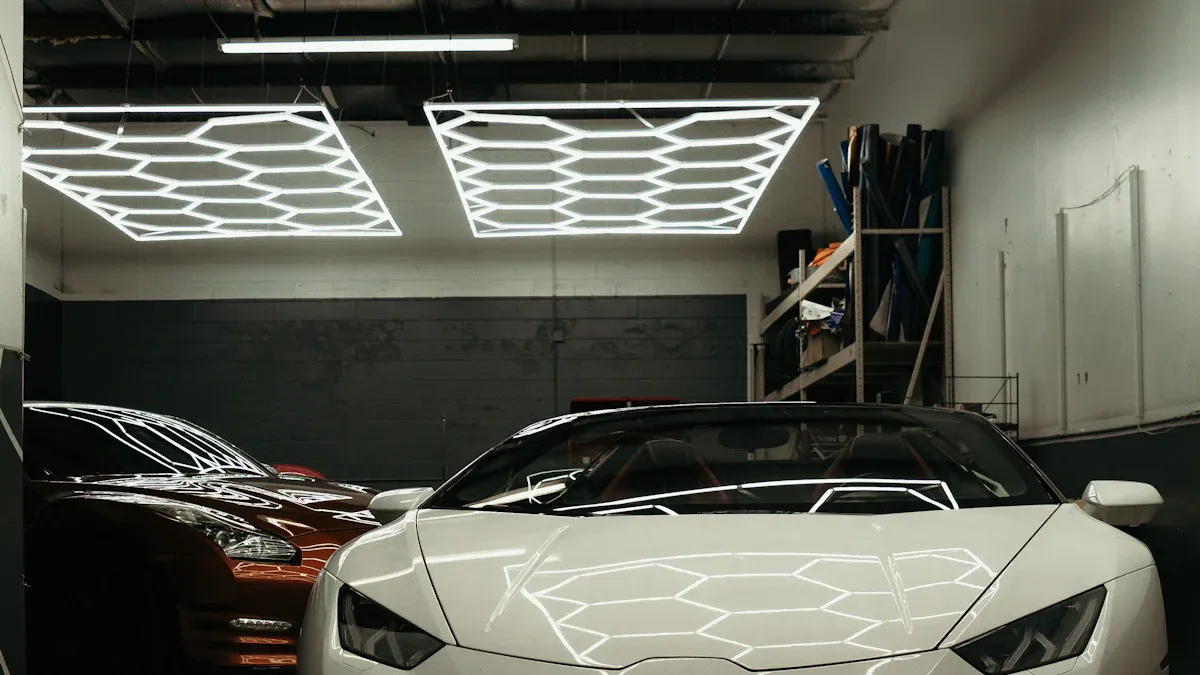
When you pick garage lights, you want them bright and easy to use. Look for lights that fit your space and handle cold or hot weather. Many people choose LED or industrial LED lights for better efficiency. If you work on projects, strong workshop lighting helps you see every detail.
Tip: Always check the brightness level before you buy.
Key Takeaways
- Measure your garage size and aim for about 50 lumens per square foot to get the right brightness.
- Choose lights based on how you use your garage: even overhead lights for parking, bright task lights for workshops, and strip lights for storage areas.
- Pick LED lights for energy savings, long life, and good performance in different temperatures to keep your garage safe and well-lit.
How to Match Garage Lights to Your Space and Needs
Assessing Garage Size and Calculating Lumens
You want your garage to feel bright and safe. The first step is to figure out how much light you need. Think about the size of your garage. A small one-car garage needs less light than a big three-car space.
Here’s a simple way to estimate the right brightness:
- Measure your garage’s length and width.
- Multiply those numbers to get the square footage.
- Plan for about 50 lumens per square foot for general use.
For example, if your garage is 20 feet by 20 feet, that’s 400 square feet. You would need about 20,000 lumens in total. You can split this up between several Garage Lights.
Tip: Always check the lumens on the box before you buy. More lumens mean a brighter garage.
Choosing Garage Lights for Different Uses (Parking, Workshop, Storage)
Not every garage is the same. Some people just park their cars. Others use the space for hobbies or storage. You should pick Garage Lights that match how you use your garage.
- Parking: You want even lighting with no dark corners. Overhead LED lights work well here.
- Workshop: You need bright, focused light. Try adding task lights over your workbench. Adjustable lights help you see small details.
- Storage: Shelves and closets need extra light. Use strip lights or small fixtures in these spots.
Here’s a quick table to help you choose:
| Use | Best Light Type | Placement Idea |
|---|---|---|
| Parking | LED ceiling lights | Center of garage |
| Workshop | Task or shop lights | Above workbench |
| Storage | Strip or puck lights | Inside shelves or closets |
Note: You can mix different types of lights for the best results.
Prioritizing Safety, Visibility, and Color Rendering
Good lighting keeps you safe. You want to see clearly when you walk or work in your garage. Bright Garage Lights help you spot tools, cords, or spills on the floor.
Color rendering is also important. This means how true colors look under the light. Lights with a high CRI (Color Rendering Index) show colors more accurately. Look for a CRI of 80 or higher. This helps you see paint colors, wires, or small parts better.
- Choose lights that spread light evenly.
- Avoid shadows in corners or near doors.
- Pick lights that turn on quickly, even in cold weather.
Safety first! Good lighting can help prevent accidents and make your garage a better place to work or park.
Key Features and Types of Garage Lights

Types of Garage Lights: LED, Fluorescent, Incandescent, and More
You have a lot of choices when it comes to Garage Lights. LED lights are the most popular. They last a long time and use less energy. Fluorescent lights give off a cool, even light. Some people still use incandescent bulbs, but they do not last as long and use more power. You can also find halogen and smart lights for special needs.
Tip: LED Garage Lights work well in most garages and save you money on your electric bill.
Brightness and Color Temperature for Garage Lights
Brightness matters a lot. You want to see everything clearly. Look for the lumens number on the box. More lumens mean a brighter light. Color temperature tells you how warm or cool the light looks. A number around 4000K to 5000K gives you a bright, daylight feel. This helps you see colors and details better.
Energy Efficiency, Lifespan, and Climate Performance
LED Garage Lights use less energy and last up to 50,000 hours. Fluorescent lights also save energy but may not work well in cold weather. Incandescent bulbs burn out fast and waste energy. If your garage gets very hot or cold, pick lights that can handle those temperatures.
Installation, Controls, and Maintenance Tips
Most Garage Lights are easy to install. You can use basic tools for most jobs. Some lights come with motion sensors or remote controls. These features make your garage safer and more convenient. Clean your lights once in a while to keep them bright.
When you pick Garage Lights, think about your space, how you use the garage, and your local weather. LED lights work best for most homes. You get better safety, comfort, and clear vision.
Good lighting makes every garage job easier and safer.
FAQ
How many garage lights do you really need?
You want enough lights to cover every corner. Measure your space, then use about 50 lumens per square foot. Add more if you work on projects.
Can you use regular household bulbs in your garage?
You can, but they might not be bright enough. LED garage lights work better. They last longer and handle cold or hot weather.
What color temperature works best for garage lighting?
Pick lights between 4000K and 5000K. This range gives you a bright, clear look. You see colors and details much better.
Tip: Always check the box for lumens and color temperature before you buy!
By: Grace
Tel: +8613906602845
E-mail: grace@yunshengnb.com
Youtube: Yunsheng
TikTok: Yunsheng
Facebook: Yunsheng
Post time: Jul-06-2025
